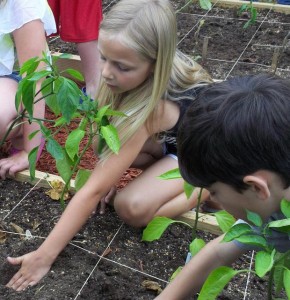 School Gardens Research A major project in The Wells Lab focused on studying the influence of school gardens on children’s health and well-being. This work was funded primarily by the USDA’s People’s Garden Healthy Gardens, Healthy Youth project and by the Robert Wood Johnson Foundation (RWJF), through its Active Living Research Program. The 2-year, 4-state research and Cooperative Extension partnership employs a true experiment (i.e., a “randomized controlled trial”) to assess how school gardens affect nutritional knowledge, fruit and vegetable consumption, physical activity, and related outcomes among elementary school children. Forty-eight schools in Iowa, Arkansas, New York, and Washington were randomly assigned to receive the garden intervention or to be in the wait-list control group that received gardens at the end of the study. Thirty Cooperative Extension educators were “on the ground” at the schools, implementing the garden intervention, delivering garden-based lessons, and collecting objective data and survey data to assess gardens’ effects on children’s health and health behaviors. The RWJF-funded study School Gardens and Physical Activity was conducted just in New York State, piggybacking on the larger-USDA People’s Garden Healthy Gardens, Healthy Youth project. To examine the effects of school gardens on children’s physical activity, three measures were used: the GEMS Activity Questionnaire (GAQ); accelerometers; and direct observation of children in the garden and in the classroom. Findings of our School Gardens and Physical Activity study, published in Preventive Medicine (December 2014), indicate:
Please feel free to download our research briefs #1 and #2 (see this page upper right) describing our findings about gardens and physical activity; research brief #3 describing the PARAGON direct observation measure; and research brief #4 regarding the effects of school gardens on science knowledge. We look forward to sharing findings regarding other effects of school gardens in the coming months. Partners. The Healthy Gardens, Healthy Youth USDA-funded project is a partnership between Washington State University, Cornell University, Iowa State University, the University of Arkansas, and the Cooperative Extensions of the four institutions. Funding. This project has been funded, in part, with Federal funds from the U.S. Department of Agriculture (USDA) through the Food & Nutrition Service (FNS) People’s Garden pilot program (Project #CN-CGP-11-0047) and by the Cornell University Agricultural Experiment Station (Hatch funds) (#NYC-327-465) and Cornell Cooperative Extension (Smith Lever funds) through the National Institutes for Food and Agriculture (NIFA) USDA. Additional funding was provided for various aspects of this project by: The Robert Wood Johnson Foundation through its Active Living Research Program (#69550); The Wellmark Foundation to the Iowa 4-H Foundation, Ames IA (# 2011-02-66); Cornell University’s Atkinson Center for a Sustainable Future (ACSF); The Cornell University Center for Behavioral Economics in Child Nutrition Small Grants Program; The Bronfenbrenner Center for Translational Research, Cornell University; The College of Human Ecology, Cornell University; and the Cornell Cooperative Extension Summer Intern Program (2011, 2012, 2013). |
Research Briefs Research Brief #1: Gardens and Physical Activity Research Brief #2: Indoor vs. Outdoor Physical Activity Research Brief #3 PARAGON: An observational measure of PA while gardening Download PARAGON here |
The contents of this website do not necessarily reflect the view or policies of the U.S. Department of Agriculture, nor does mention of trade names, commercial products, or organizations imply endorsement by the U.S. Government.
Selected Publications
Cosco, NG, Wells, NM, Monsur, M, Goodell, L.S, Zhang, D, Xu, T, Hales, D, Moore, RC (2021). Research Design, Protocol, and Participant Characteristics of COLEAFS: A cluster randomized controlled trial of a childcare garden intervention. International Journal of Environmental Research and Public Health.
Rollings, KA & Wells, NM (2018). Cafeteria Assessment for Elementary Schools (CAFES): Development, reliability testing, and predictive validity analysis. BMC Public Health,18 (1), 1154. doi: 10.1186/s12889-018-6032-2
Brittin J, Frerichs L, Sirard JR, Wells NM, Myers BM, Garcia J, Sorensen D, Trowbridge MJ, Huang TTK (2017). Impact of Active School Design on School-Time Sedentary Behavior and Physical Activity: A Pilot Natural Experiment. PLoSONE 12(12): e0189236. doi: 10.1371/journal.pone.0189236
Rollings, K.A. & Wells, N.M. (2017). Effects of residential kitchen floor plan openness on eating behaviors. Environment & Behavior, 49(6). doi: 10.1177/0013916516661822
Myers, B.M. & Wells, N.M. (2015). Children’s physical activity while gardening: development of a valid and reliable direct observation tool. Journal of Physical Activity & Health, 12 (4), 522-528. doi: 10.1123/jpah.2013-0290
Wells, N.M., Myers, B.M., & Henderson, C.R. (2014). School gardens & physical activity: A randomized controlled trial of low-income elementary schools. Preventive Medicine, 69S, S27-S33. doi: 10.1016/j.ypmed.2014.10.012
Wells, N.M. and Yang, Y. (2008). Neighborhood Design & Walking: A quasi-experimental longitudinal study of low-income Southern women moving to neotraditional or suburban neighborhoods. American Journal of Preventive Medicine, 34(4), 313-319. doi: 10.1016/j.amepre.2008.01.019
